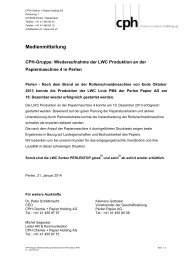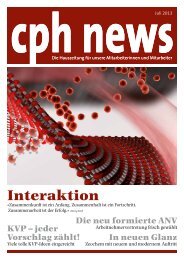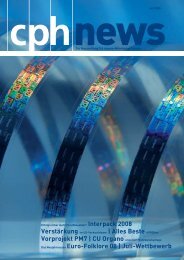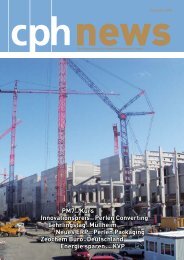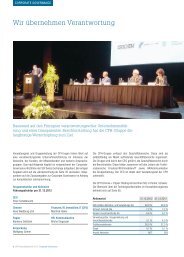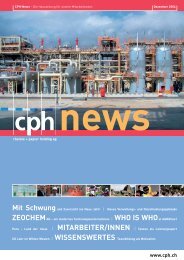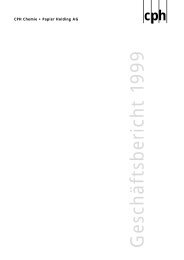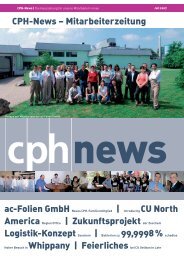Beste Agroline Vorprojekt PM7 - CPH Chemie + Papier Holding AG
Beste Agroline Vorprojekt PM7 - CPH Chemie + Papier Holding AG
Beste Agroline Vorprojekt PM7 - CPH Chemie + Papier Holding AG
Erfolgreiche ePaper selbst erstellen
Machen Sie aus Ihren PDF Publikationen ein blätterbares Flipbook mit unserer einzigartigen Google optimierten e-Paper Software.
also being extended to include countries such as Kazakhstan,<br />
Uzbekistan etc., which are joining this pipeline network.<br />
We have recently heard that Switzerland is buying gas from<br />
Iran. How does this work? The answer is that gas is put<br />
into the pipeline network in Iran, where a series of large<br />
pipelines carries the gas north through Turkey, across<br />
the Balkans, Austria, Germany and Switzerland.<br />
In the Middle East, however, the chosen method of transportation<br />
is to liquefy this gas.<br />
In order to do this, a plant is constructed which purifies the<br />
natural gas to largely methane only and cools this gas down<br />
to around -200°C, when the gas liquefies. It is then pumped<br />
away to storage in massive tanks at a low temperature AND<br />
at a low pressure. The temperature MUST be kept very low<br />
to prevent the pressure building up. If the natural gas were<br />
allowed to warm up to normal temperatures, the pressure<br />
would be up to round 100 barg.<br />
From these large cold tanks the LNG carriers are loaded on<br />
specially built piers; and the ships use gas which boils off to<br />
power the ship’s engines to the destination port in Europe,<br />
North America, Japan or Korea.<br />
Present day feeder terminals are sited in Qatar, Algeria,<br />
Oman, Egypt, Indonesia, Malaysia, Australia and Nigeria.<br />
One of the early steps in the plant to make the LNG is the<br />
purification of the feed gas. This includes dehydration using<br />
molecular sieve and CO2 removal, generally with an amine.<br />
Hence Zeochem molecular sieve plays an important part in<br />
the preparation of the gas for liquefaction. The gas is successively<br />
compressed, cooled, and then recompressed<br />
using a series of chilling cycles. It is like a massive deep<br />
freezer, working down to -200°C.<br />
The Egyptian LNG plant at Idku is on the Mediterranean<br />
coast. It is one of two plants in Egypt, and has been running<br />
successfully with Zeochem molecular sieve for around<br />
three years.<br />
Just recently Zeochem was asked to be present to check<br />
the running of the molecular sieve adsorbers and then to<br />
oversee and inspect the recharge.<br />
Peter Hawes was on-site with Mohamed Fouad from our<br />
Egyptian agents.<br />
Breakthrough testing<br />
In order to check the working of the molecular sieve, an instrument<br />
called a hygrometer is used, which can measure<br />
moisture contents down to fractions of a part per million.<br />
The pictures give a panorama of the site<br />
This instrument must be correctly calibrated before being<br />
connected to the adsorbers on site. Round-the-clock monitoring<br />
ensures that the breakthrough of moisture is seen<br />
immediately, so no moisture passes through into the cryogenic<br />
part of the plant.<br />
Shut-down<br />
Once this test was completed, the plant was shut down for<br />
its three-yearly inspection.<br />
As part of this shut-down, the molecular sieve adsorbers<br />
are emptied, inspected and then refilled with a fresh molecular<br />
sieve. Packing a column with tiny beads and ensuring<br />
that no leaks can occur during the next three years is work<br />
which needs thorough checking.<br />
In this case the work was done by a company from Saudi<br />
Arabia that specialises in changing out adsorbents and catalysts.<br />
Our specialist has to get inside the vessel to inspect<br />
the vessel itself, as well as the completed work.<br />
Cranes then haul the 600 kg big bags up to the top of the<br />
vessel where they are emptied into the clean vessel.<br />
Including inert balls as special protection, there were a total<br />
of six layers of packing in the column. All had to be levelled<br />
off before the next layer was poured into the column.<br />
Zeochem <strong>AG</strong><br />
Peter Hawes




